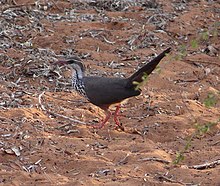| Mesites | |
|---|---|

| |
| Subdesert mesite (Monias benschi) | |
| Scientific classification | |
| Domain: | Eukaryota |
| Kingdom: | Animalia |
| Phylum: | Chordata |
| Class: | Aves |
| Clade: | Columbimorphae |
| Order: | Mesitornithiformes Wetmore, 1960 |
| Family: | Mesitornithidae Wetmore, 1960 |
| Genera | |

| |
| Respective ranges: brown mesite in orange, white-breasted mesite in green and subdesert mesite in blue | |
The mesites (Mesitornithidae) are a family of birds that are part of a clade (Columbimorphae) that include Columbiformes and Pterocliformes. They are smallish flightless or near flightless birds endemic to Madagascar. All the species of this clade are listed as vulnerable.
Description
The mesites are forest and scrubland birds that feed on insects and seeds; brown and white-breasted mesites forage on the ground, gleaning insects from underneath leaves as well as low vegetation. The subdesert mesite uses its long bill to probe in the soil. Other birds, such as drongos and flycatchers, will follow mesites to catch any insects they flush out or miss. Mesites are vocal birds, with calls similar to a passerine song, used for territorial defence. Two or three white eggs are laid in a stick-built nest located in a bush or on a low branch. The Mesitornis species are monogamous while Monias benschi is polygamous and, unlike the other two, shows significant sexual dichromatism.
Systematics
There are two genera, Mesitornis (2 species) and Monias (subdesert mesite).
| Image | Genus | Species |
|---|---|---|

|
Monias Oustalet & Grandidier, 1903 |
|

|
Mesitornis Bonaparte, 1855 |
|
Historically, mesites' phylogenetic relationships were not very clear; they have been allied with the Gruiformes, Turniciformes and Columbiformes.
Some phylogenomic studies support Pterocliformes (sandgrouse) as the sister group of mesites while others place this clade with another clade constituted of Columbiformes and Cuculiformes (cuckoos).
| |||||||||||||||
| Phylogenetic relationship of the mesites within Neoaves acording to Stiller and colleagues (2024). |
References
- ^ Jarvis, E.D.; et al. (2014). "Whole-genome analyses resolve early branches in the tree of life of modern birds". Science. 346 (6215): 1320–1331. Bibcode:2014Sci...346.1320J. doi:10.1126/science.1253451. PMC 4405904. PMID 25504713.
- Archibald, George W. (1991). Forshaw, Joseph (ed.). Encyclopaedia of Animals: Birds. London: Merehurst Press. pp. 100–101. ISBN 978-1-85391-186-6.
- Gamero, Anna; Székely, Tamás; Kappeler, Peter M. (2014). "Delayed juvenile dispersal and monogamy, but no cooperative breeding in white-breasted mesites (Mesitornis variegatus)". Behavioral Ecology and Sociobiology. 68: 73–83. doi:10.1007/s00265-013-1624-4. S2CID 17145658.
- IOC World Bird List v6.3 . "IOC Names File Plus 6.3". Retrieved 30 August 2016.
- "Part 7- Vertebrates". Collection of genus-group names in a systematic arrangement. Archived from the original on 5 October 2016. Retrieved 30 June 2016.
- Sibley, Charles; Jon Edward Ahlquist (1990). Phylogeny and classification of birds. New Haven: Yale University Press. ISBN 0-300-04085-7.
- Livezey, Bradley C.; Zusi, RL (January 2007). "Higher-order phylogeny of modern birds (Theropoda, Aves: Neornithes) based on comparative anatomy. II. Analysis and discussion". Zoological Journal of the Linnean Society. 149 (1): 1–95. doi:10.1111/j.1096-3642.2006.00293.x. PMC 2517308. PMID 18784798.
- Hackett, Shannon J.; Kimball, Rebecca T.; Reddy, Sushma; Bowie, Rauri C. K.; Braun, Edward L.; Braun, Michael J.; Chojnowski, Jena L.; Cox, W. Andrew; Han, Kin-Lan; Harshman, John; Huddleston, Christopher J.; Marks, Ben D.; Miglia, Kathleen J.; Moore, William S.; Sheldon, Frederick H.; Steadman, David W.; Witt, Christopher C.; Yuri, Tamaki (2008). "A Phylogenomic Study of Birds Reveals Their Evolutionary History". Science. 320 (5884): 1763–1768. Bibcode:2008Sci...320.1763H. doi:10.1126/science.1157704. PMID 18583609. S2CID 6472805.
- Fain, Matthew G.; Houde, Peter (2004). "Parallel radiations in the primary clades of birds". Evolution. 58 (11): 2558–2573. doi:10.1554/04-235. PMID 15612298. S2CID 1296408.
- Yuri, T.; et al. (2013). "Parsimony and Model-Based Analyses of Indels in Avian Nuclear Genes Reveal Congruent and Incongruent Phylogenetic Signals". Biology. 2 (1): 419–444. doi:10.3390/biology2010419. PMC 4009869. PMID 24832669.
- H Kuhl, C Frankl-Vilches, A Bakker, G Mayr, G Nikolaus, S T Boerno, S Klages, B Timmermann, M Gahr (2020) An unbiased molecular approach using 3’UTRs resolves the avian family-level tree of life. Molecular Biology and Evolution, https://doi.org/10.1093/molbev/msaa191
- Stiller, J.; Feng, S.; Chowdhury, A-A.; et al. (2024). "Complexity of avian evolution revealed by family-level genomes". Nature. 629 (8013): 851–860. Bibcode:2024Natur.629..851S. doi:10.1038/s41586-024-07323-1. PMC 11111414. PMID 38560995.
| Taxon identifiers | |
|---|---|
| Mesitornithidae | |